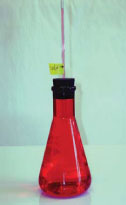Education: Activities & Documents
Thermal Expansion

Most substances expand when heated and contract when cooled. As the temperature of most substances increases, their molecules vibrate faster and move farther apart, occupying a larger space. When these substances are cooled, their molecules vibrate slower and remain closer to each other. Note that freshwater below 4°C actually expands when cooled, a phenomena known as the anomaly of water. Thermal expansion is the principle by which a liquid thermometer works. In the ocean, thermal expansion is thought to contribute significantly to sea level rise on decadal-to-century-long time scales. However, thermal effects appear to be influenced by decadal climaterelated fluctuations, making it difficult to estimate the long-term contribution of thermal expansion to sea level rise. Current estimates suggest that thermal expansion is responsible for 25 percent to 50 percent of observed sea level rise.
In this activity, we look at thermal expansion and attempt to predict what will happen to the ocean's volume if ocean waters become warmer. Credit: Karp-Boss, L., E. Boss, H. Weller, J. Loftin, and J. Albright (2009). Teaching Physical Concepts in Oceanography: An Inquiry Based Approach. Oceanography 22(3), supplement, 48 pp.
teaching_phys_concepts_hi.pdf (27.0 MB)
